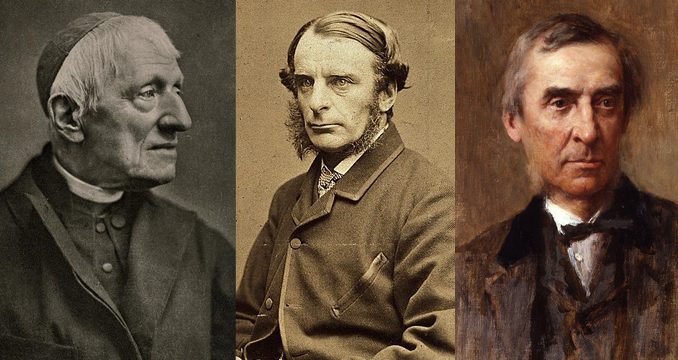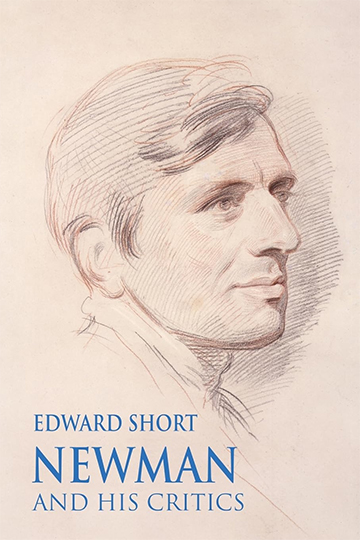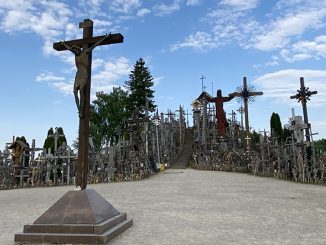
Of all nineteenth-century Catholic thinkers, John Henry Newman is the one who continues both to shape intellectual currents in modern Catholicism and offer an interesting dialogue partner to Protestants such as myself. While his patristic scholarship is now outdated and his novels are largely forgotten, his thoughts on doctrinal development, university education, and the nature and grounds of belief are perennial contributions to Christian thought. His Oxford sermons, preached before his conversion to Rome, offer some of the most outstanding examples of Christology preached and applied. And, compared to the bombast of Carlyle, he is surely one of the great prose stylists of his day.
Given this, it is hard to grasp just how controversial he was in his own time. But for a leading Anglican churchman to first lead a movement building on the high church tradition within the Church of England and then to swim the Tiber was at the time explosive. One might say of him as Nietzsche said of himself–he was dynamite. As the forces of modernity started to reshape English life through Catholic Emancipation, the Reform Acts, the Industrial Revolution, and Irish immigration, a deeply Protestant society underwent a convulsive and transformative process. Cultural attitudes often lag behind economic transformations and the legal changes they make necessary.
And so when Newman converted in 1845, to describe him, as Manning did, as the most dangerous man in England may have been hyperbole, but not by much: Newman’s biography embodied the intellectual and ecclesiastical drama of the age.
Newman continues to be controversial. First, interpreting him in the wake of Vatican II has proved tricky. If he were alive today, would he be conservative or liberal? There are advocates for both. And in the field of Newman studies, partisanship runs deep. But there is much more to Newman than his thought. And that is where the work of Edward Short has proved so helpful.
Newman and His Critics is the fourth volume in a series that began with Newman and His Contemporaries and continued with Newman and History and Newman and His Family. (Short is currently working on a fifth book, titled Newman and the Saints.) In each book, Short approaches Newman via the various figures with whom he interacted over many years. Short is helped in this by the fact that Newman was a man of letters in both senses of the word. His essays, reviews, sermons, and books all demonstrate both learning and literary flair. He was a master of letters in this sense.
But he was also a remarkable correspondent, writing to everyone from nieces and nephews to the great and the good. And these are a trove that allows the reader to see Newman as a human being and to set his work and his professional interactions in a personal context. Short has read the voluminous correspondence and, in this volume, as in the earlier two, this shows on almost every page. Indeed, in an era of texts and emails, one wonders if such a book could ever be written about anyone alive today.
Newman was controversial and a great controversialist, and so Short is necessarily selective in his choice of characters from the large cast of critics available. But his treatment of each justifies his choices. Among them there is Newman’s friend and Oxford Movement collaborator, Richard William Church; J. A. Froude, brother of Newman’s early friend and partial mentor, Hurrell Froude; Mark Pattison, a restless protegee who moved far from the thought of his mentor; and, of course, Charles Kingsley who might have been remembered today simply as a fine advocate of social reform had he not picked an unnecessary fight with Newman. Short devotes a chapter to each. He is careful not to reduce them to their relationship with Newman. Instead, he provides a thorough biography of the subject, which allows him to set the connection to Newman in a broader context.
I confess that the first chapter I read was that on Kingsley. Kingsley was a good man, arguably a better novelist than Newman, and someone who did not need to engage in silly attacks on others, particularly those who were sharper intellects and more effective polemicists than himself. Nonetheless, he did so. It is his gratuitous claim in a review of a book by J. A. Froude that Newman (and the Roman clergy) find dishonesty and deception to be acceptable that provokes Newman’s greatest literary moment: his Apologia pro Vita Sua.
In one of the most scholarly sections in the book, Short summarizes the various reasons that have been proposed as to why Kingsley engaged in such an unprovoked attack. Short sees it as providential because it calls forth such a remarkable response from Newman. Perhaps—although the universal scope of providence makes providential arguments less than satisfactory when it comes to particular actions and events. What is certainly the case is that the Apologia is a remarkable achievement. Not only is it a spiritual autobiography, but it is also an important text of the times. Between 1830 and 1850, many European established churches underwent dramatic divisions, often connected to the complexity of church-state relations in the post-Napoleonic, industrial world. The Apologia is the most personal account of such conflict, played out on the stage of society at large and in the heart of a leading churchman.
One important contribution Short makes to the Kingsley matter is the evidence he provides, drawn from letters, that Newman bore his opponent no lasting ill-will. Newman even retained warm and kind affection for Mark Pattison, who surely disappointed him perhaps the most. Indeed, Newman’s comparative lack of rancor towards critics is a theme that runs throughout the book. Certainly, Newman was one of the most able controversialists of his day and could be ruthless. But the lack of bitterness is remarkable.
I commented earlier on the role of letters as a source in Newman’s life and Short’s biography, something our day of internet and social media has killed. I wonder too if the form of letter writing, making swift responses harder, requiring more thought, and operating with certain protocols of address, helped Newman and his contemporaries. Did it perchance make them rather more human and humane than we have become today? Further, as Short says right at the start of the book, friendship was a delight to Newman. The man who takes joy in friends—the man who is grateful for friends — is likely less prone to the bitterness and anger that is sadly so prevalent in communication today.
One surprising omission by Short is Cardinal Manning, the other controversial Roman convert in Victorian England, who left Canterbury for Rome after the Gorham Case—and thus later than Newman, but who received the cardinal’s hat before his rival. It would have been entertaining to see how Short handled him, and even more fun if he had also taken on Manning’s acerbic biographer, Lytton Strachey. I was also surprised to see Ian Ker, Newman’s modern biographer, listed as a critic. His book on the cardinal is vast, and I cannot recall a single significant criticism of Newman—a point that has made the book controversial in the divisive world of Newman scholarship. Still, that chapter stands perhaps as a testimony to the power of Newman-style friendship in the twentieth century, between Ker and Short.
While Short is clearly a fan of Newman, he does not engage in significant discussion of his hero’s theology, even when there were moments that it might have been fascinating. I was intrigued by Pattison’s comment that Newman was hindered by his lack of German and thus his lack of exposure to German philosophy. Certainly, the advocate of development might have read with profit Hegel and deployed him to strengthen his approach—something Bernard Lonergan was to do in the twentieth century.
And, as a Protestant, I have to dissent from the dismissal of Protestantism as rationalism; that claim begs far too many questions. But theology is not Short’s brief; his purpose throughout his works has been to bring out Newman’s fundamental humanity—‘decency’, to use the traditional English idiom—and that he does most successfully. This is a fine and enjoyable volume, a testimony not just to Newman’s greatness but also to the power of friendship and humane letters.
(Editor’s note: This is Mr. Short’s fourth book on Newman; the headline and related body copy of this review have been corrected to reflect this.)
Newman and His Critics
by Edward Short
Gracewing, 2024
Paperback/Hardcover, 612 pages
If you value the news and views Catholic World Report provides, please consider donating to support our efforts. Your contribution will help us continue to make CWR available to all readers worldwide for free, without a subscription. Thank you for your generosity!
Click here for more information on donating to CWR. Click here to sign up for our newsletter.





Do children still read Charles Kingsley’s “The Water Babies” anymore?
The mentioned Lonergan blurred too much the distinction between divine revelation and human insight. Even much more so, Hegel. A difficult thing to get right, but an easy thing to get “left.”
In what way is Newman’s patristic scholarship now outdated? (Brief, please, for a non-specialist).
The writer likely means that Newman is writing of others no longer known today, or less likely that he (the writer) is taken in by what C.S. Lewis meant by “chronological snobbery.”
Newman spent most of his life unaware of the existence of the Didache, which was discovered in 1873, with an English translation coming out in 1884. Other Patristic writings that had not yet come to light include the Apostolic Tradition of Hippolytus and a whole stack of works written by Augustine. Also, there were certain forgeries and scribal interpolations that had not yet been ferreted out during Newman’s lifetime. I think these are the things the author is referring to, though he may be referrring to something else.
Thanks, Mr. Beaulieu, for your answer to my question.
Or does outdated mean considered wrong today? It matters because I understand that many Protestants are coming to Catholicism today through their study of the Fathers.
I think that’s exactly what the author intended to imply. He’s a friendly Protestant writing a positive piece on Newman for a Catholic audience. Since Newman’s patristics have proven “game, set and match” for so many former Protestants, make a vague allusion to recent Protestant claims that the Fathers were really proto-Protestants and then move on. I think that’s what the author was getting at.